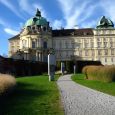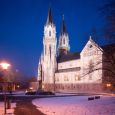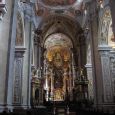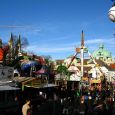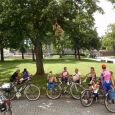Klosterneuburg
Advertisement
By Train
The train (line S40) runs in 30-minute intervals (stop-Klosterneuburg Kierling).Even with the bike you can quickly and Klosterneuburg on the Danube Bicycle Path to reach (north and south shores).
By Bus
Klosterneuburg is accessible by car from Vienna on the highway 14th Between the federal capital Vienna and Klosterneuburg circulate at regular intervals of rapid transit buses and OBB.
By Ferry
In addition there is the possibility, at Korneuburg (Tuttendorfl) with a rolling ferry also from the north bank of the Danube on reset (A22) to Klosterneuburg.
By Bicycle
Even with the bike you can quickly and Klosterneuburg on the Danube Bicycle Path to reach (north and south shores).
Advertisement
Essl Museum
The Essl is an Austrian by the businessman Karlheinz Essl Sr. (b. 1939) and his wife Agnes (nee Schomer) compiled collection of works of contemporary art.The in Klosterneuburg in Vienna on 5 and specially constructed Essl Museum opened in November 1999 was designed by the architect Heinz Tesar.The private collection has nearly 7,000 works (February 2011) one of the largest in Austria.It includes works of art of the 20th and the early 21st Century, particularly the Austrian art scene since 1945.A particularly large space occupied by the Austrian art after 1945.She is one of the largest private collections in Austria.Since 2005, every two years as part of the museum of the Essl Award for Central and Eastern Europe artists from the countries of Central and Eastern Europe, where the company Essl bauMax award is represented.Some past winners include in the meantime to internationally known artists such as Catherine Seda or Jakub Nepras.On 1 Expended in May 2011 the Austrian Post AG as part of the definitive stamp series Art houses a stamp on the object.
Church of St. Martin
The church of St. Martin in the north of Klosterneuburg is a Roman Catholic parish church and the sainted Martin of Tours, dedicated.It is Austria's second oldest church of St. Martin, part of the deanery Klosterneuburg the Archdiocese of Vienna and by the Stift Klosterneuburg care.The church was built on a slight terrace edge in a dominant position on the Danube, with poorly trained military Kirchenhofmauer.In the southern part of the church was a Frankish settlement.End of the 8th Century, during the Awarenkriege, a wooden church was built with a series of cemetery, was dedicated to St. Martin of Tours.In the early Romantic period (11th century), a rectangular stone structure was built with square choir.In the 12th Century expands the sacred to the east and west. End of the 13th Century, was razed to the High Romanesque church and by an early Gothic building replaced.Its nave is essentially the modern state. 1291 Knights donated by Ulrich Kritzendorf a St. Bartholomew and St. Mary Magdalene's Chapel (now the vestry ), grown in the south of the nave. 1363 was the building of the tower or its increase.Around 1420 the foundation stone was laid for the present chancel with three yoke and a final five-eighths, which has over the old by a yoke and more over the long house is too high.Furthermore, in the 15th Century, the nave increased and provided with pilasters and connected the south side chapels and expanded eastward so that an aisle-like attachment is created.
Klosterneuburg Abbey
The beautiful monastery is located in Lower Austria, Klosterneuburg is a pen and the Austrian Congregation of Augustinian canons.The basilica has a Romanesque origin with Gothic additions.The interior is baroque shaped with frescoes among others Johann Michael Rottmayr.The pin was in 1114 when Sakularkanonikerstift by the Austrian Margrave Leopold III. the saint founded.The original goal of the Marquis was that there - would be built a cathedral for the diocese of the country, but not least due to the resistance of the responsible bishop of - at the residence of the Marquis Babenberg Passau failed.First provost Sakularkanonikerstiftes this was the major medieval German historian Otto of Freising, a son of the Marquis.After the apparent failure of plans for a separate diocese in 1133 attracted the Austrian state regulated the Augustinian Canons in Klosterneuburg. First provost of the new community was blessed Hartmann.In a side chapel of the cloister (the Leopold Chapel) is the tomb of Leopold III. with the famous Verdun Altar from the year 1181, for the 1330 triptych has been redesigned.The back of the Verdun Altar shows images of Mary's life and one of the oldest monumental panel paintings of Austrian art.In the Gothic fountain house is the bronze seven-armed candlestick of Agnes from the early 12th Century.
Gugging Museum
The museum is located in gugging the Art / Brut Center's main building.It is divided into a permanent exhibition area the "gugging classics" and another space for changing exhibitions.The "gugging classics" standing area hosts a collection of exceptional paintings, drawings, prints and objects by the Gugging Artists.Therefore this part of the museum offers a general overview of works from the past 40 years up to the present activity.The works created by 30 artists all together, are regularly Exchanged So that even this section constantly offers new pieces to the viewer.They come from an own Private Foundation - Artists from Gugging or have been borrowed from other collections and museums.Due to the important historic and present role that Gugging has played in the development of Art Brut, the primar museum focuses on this field.Through the use of changing exhibitions the museum now offers space for developing deeper and more comprehensive concepts, ie discovering rare details in Gugging Art Above all this includes a resist presentation of other Austrian and international art brut representatives.
Vienna Woods War Memorial
is a war memorial during the First World War by soldiers near the city limits of Vienna in the municipality of Weidlingbach built.The building is under monument protection.The Vienna Woods War Memorial was built in 1916 by soldiers of the Austro-Hungarian army on the plans and under the leadership of Engelbert Robert Tula, a militia lieutenant, in their spare time on one of Prince Johann Schwarzenberg in today's Black Mountain Park built on land provided.After the completion of the structure of the Lieutenant War Department reported on the work completed report and asked for the arrangement of a consecration ceremony with a military chaplain and a military band.The ministry praised the officer but for this patriotic action, reprimanded him but that he the official channels had not complied and asked for permission beforehand.The sale of the commemorative publication written by him and postcards, he wanted to send the proceeds equally between the Red Cross in Austria-Hungary, Germany and Bulgaria and the Red Crescent in Turkey, was forbidden to him. Donations that had made the team, he had to pay back.If and when the approved simple consecration ceremony was held is not known.Since it was after the First World War, the Black Mountain Park barely even cared, the meadow, over the years has been overgrown by trees and was also at the Vienna forest plants take root heroes monument itself.
April - July
September - December
Information not available
Advertisement

